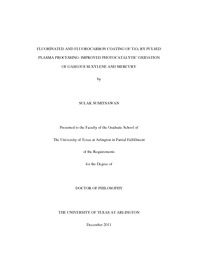
ATTENTION: The works hosted here are being migrated to a new repository that will consolidate resources, improve discoverability, and better show UTA's research impact on the global community. We will update authors as the migration progresses. Please see MavMatrix for more information.
Show simple item record
| dc.contributor.author | Sumitsawan, Sulak | en_US |
| dc.date.accessioned | 2012-04-11T20:59:32Z | |
| dc.date.available | 2012-04-11T20:59:32Z | |
| dc.date.issued | 2012-04-11 | |
| dc.date.submitted | January 2011 | en_US |
| dc.identifier.other | DISS-11397 | en_US |
| dc.identifier.uri | http://hdl.handle.net/10106/9642 | |
| dc.description.abstract | Titanium dioxide (TiO₂) is a preferred catalyst for photocatalytic oxidation of many air pollutants. In an effort to enhance its photocatalytic activity, TiO₂ was modified by pulsed plasma treatment. In this work, TiO₂ nanoparticles, coated on a glass plate, were treated with a plasma discharge of hexafluoropropylene oxide (HFPO) gas. By appropriate adjustment of discharge conditions, it was discovered that the TiO₂ particles can be either directly fluorinated (Ti-F) or coated with thin perfluorocarbon films (C-F). Specifically, under relatively high power input, the plasma deposition process favored direct surface fluorination. The extent of Ti-F formation increased with increasing power input. In contrast, at lower average power inputs, perfluorocarbon films are deposited on the surface of the TiO₂ particles. The plasma surface modified TiO₂ nanoparticles were subsequently employed as catalysts in the photocatalytic oxidation of m-xylene, as carried out inside a closed loop batch reactor. Both types of modified TiO₂ were significantly more catalytically active than that of the unmodified particles. For example, the rate constant of m-xylene degradation was increased from 0.012 min-1 with untreated TiO₂ to 0.074 min-1 with fluorinated TiO₂. The plasma treatment converts the TiO₂ particles from hydrophilic to hydrophobic. The more hydrophobic TiO₂ surfaces will more readily adsorb non-polar compounds, such as m-xylene, while simultaneously minimizing the competitive adsorption of water molecules. Additionally, it is believed that the presence of surface fluorine atoms can contribute to decreased electron-hole recombinations, thus further increasing TiO₂ photocatalytic activity. Similarly, the promotional effect was also found in elemental mercury, another non-polar compound, where the removal rate of elemental mercury obtained from fluorinated TiO₂ was 1.6 times greater than that of the untreated TiO₂. In contrast, fluorinated TiO₂ showed less reactivity than that of the untreated TiO₂ in degrading acetaldehyde, a polar compound. The study of the effect of relative humidity on m-xylene degradation revealed that the optimum relative humidity for m-xylene removal was 10% for the untreated TiO₂. The removal efficiency was observed to decrease progressively as the relative humidity was raised above the 10% level. When fluorinated TiO₂ was used as the catalyst, the impact of relative humidity range from 0 to 40% was minimal. The inhibition effect of water vapor was not observed until the relative humidity was raised to 60% and 80%. The photocatalytic reactivity of catalyst used in successive runs was lower than that obtained with fresh TiO₂. The catalytic deactivation observed apparently results from deposition of carbonaceous species deposited on the surface of the TiO₂ particles after repeated use. However, it was discovered that subjection of the used catalysts to an oxygen plasma for 10 minutes was successful in regenerating catalyst activity to 96% of its original activity. | en_US |
| dc.description.sponsorship | Timmons, Richard | en_US |
| dc.language.iso | en | en_US |
| dc.publisher | Civil & Environmental Engineering | en_US |
| dc.title | Fluorinated And Fluorocarbon Coating Of TiO₂ By Pulsed Plasma Processing: Improved Photocatalytic Oxidation Of Gaseous M-Xylene And Mercury | en_US |
| dc.type | Ph.D. | en_US |
| dc.contributor.committeeChair | Timmons, Richard B. | en_US |
| dc.degree.department | Civil & Environmental Engineering | en_US |
| dc.degree.discipline | Civil & Environmental Engineering | en_US |
| dc.degree.grantor | University of Texas at Arlington | en_US |
| dc.degree.level | doctoral | en_US |
| dc.degree.name | Ph.D. | en_US |
Files in this item
- Name:
- Sumitsawan_uta_2502D_11397.pdf
- Size:
- 1.478Mb
- Format:
- PDF
This item appears in the following Collection(s)
Show simple item record


